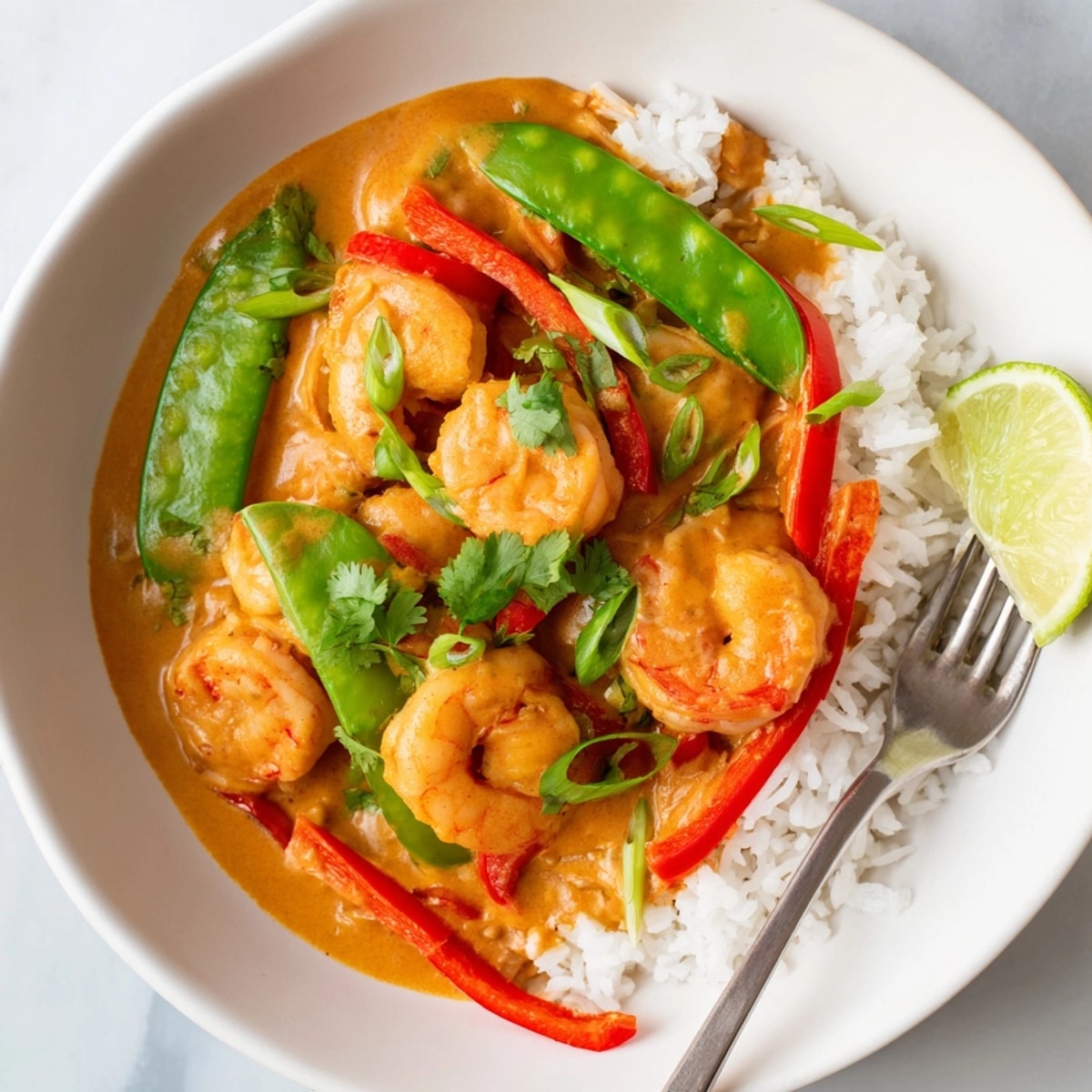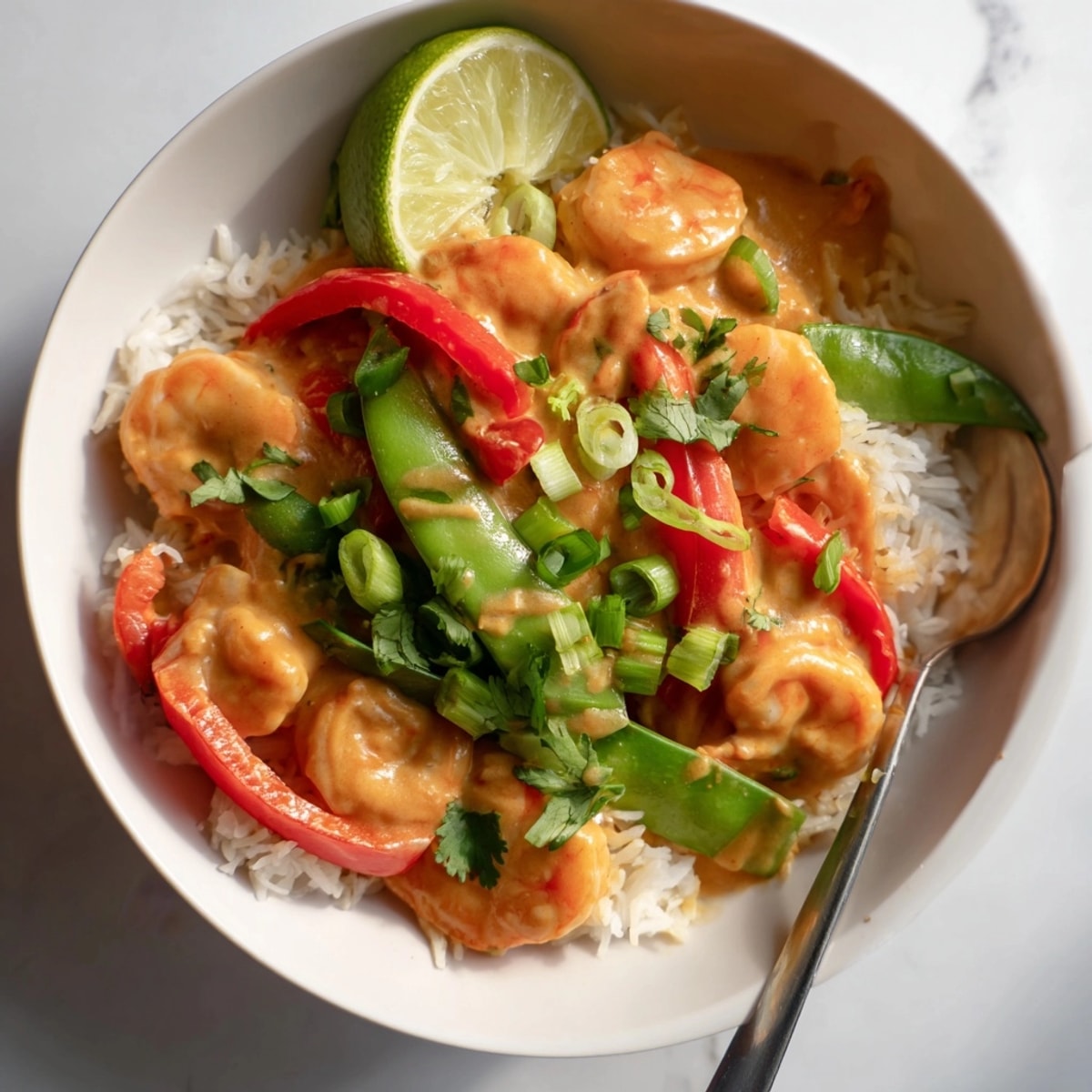
Enjoy a bowl combining tender shrimp simmered in creamy coconut curry sauce with aromatic jasmine rice. Sautéed vegetables and fresh herbs bring vibrant colors and flavors. Simple to prepare, this dish features red curry paste, ginger, garlic, and bell pepper for depth, while lime juice adds brightness. Serve it topped with cilantro, green onions, and lime wedges. Flexible for dietary needs—swap shrimp for tofu or chicken and try brown or cauliflower rice as a base. Perfect for a satisfying, colorful meal that's dairy- and gluten-free when using tamari.
This coconut curry shrimp and rice bowl is the sort of meal that instantly brightens a busy weeknight but feels special enough for guests. Tender shrimp swim in a fragrant coconut curry sauce, paired with crisp veggies and nestled over a bed of jasmine rice. Each spoonful delivers warmth, comfort, and a pop of color.
The first time I made this for my family, the kitchen filled with the aroma of coconut and ginger and in minutes everyone was asking for seconds. We now crave it any time the weather turns chilly or a celebration calls for something bright and delicious.
Ingredients
- Shrimp: fresh or frozen large shrimp give this dish its signature succulence. Look for wild-caught or sustainably farmed for best flavor and texture.
- Jasmine rice: the base of the bowl with a soft floral aroma. Rinse well before cooking for fluffier grains.
- Coconut milk: full fat provides creamy richness and body. Check labels for quality and minimal additives.
- Red curry paste: brings signature heat and depth. Use a trusted brand for authentic taste or homemade for extra flavor.
- Vegetable oil: perfect for high heat cooking and keeps the curry smooth.
- Onion: finely chopped to create a mellow background sweetness.
- Garlic: minced for bright punch and essential aroma.
- Fresh ginger: minced to add zing and subtle warmth.
- Red bell pepper: a pop of color and gentle sweetness. Choose one with taut skin and vivid hue.
- Snap peas: quick-cooking, crunchy, and sweet. Trim for tenderness and avoid stringy pieces.
- Low sodium chicken or vegetable broth: enhances the sauce without overpowering
- Soy sauce or tamari: for gluten free subtle umami and seasoning.
- Brown sugar: light sweetness to balance dinner flavors
- Lime juice: brings brightness and balances the coconut richness. Pick a plump juicy lime.
- Fresh cilantro: for freshness and mild citrusy notes
- Green onion: garnish for crisp bite
- Lime wedges: for extra zest at serving
Instructions
- Cook the Rice:
- Prepare jasmine rice using package directions. Rinse thoroughly in cool water before cooking to remove excess starch for fluffy results.
- Sauté the Aromatics:
- Heat vegetable oil in a wide skillet or wok over medium heat. Add the finely chopped onion and let it cook slowly for two to three minutes until glassy and soft but not brown. This step sets the sweet base for your sauce.
- Infuse with Flavor:
- Stir in the minced garlic and ginger. Allow them to bloom for a full minute so their fragrance releases and melds with the onion.
- Toast the Curry Paste:
- Add the red curry paste directly to the pan. Stir continually for another minute. The paste will darken slightly and its aroma will become more intense to signal the spices are toasted.
- Cook the Veggies:
- Add thin slices of red bell pepper and trimmed snap peas. Sauté them for two or three minutes so they soften but still retain crispness and vibrant color.
- Make the Sauce:
- Pour in coconut milk, broth, soy sauce, and brown sugar. Mix thoroughly and bring to a gentle simmer. Let this sauce bubble lightly so all flavors combine beautifully and develop a silky texture.
- Cook the Shrimp:
- Slip the peeled and deveined shrimp into the warm sauce. Cook for three to four minutes just until the shrimp turn bright pink and opaque. Avoid overcooking so they stay tender.
- Finish and Balance:
- Stir in fresh lime juice. Taste the sauce and adjust lime, soy, or sugar until the flavors sing balanced sweet, salty, tangy, and aromatic.
- Assemble and Garnish:
- Divide the cooked rice among four bowls. Top generously with curry shrimp and vegetables. Scatter cilantro and green onions over each bowl and add lime wedges if you like.

The coconut milk in this recipe is my absolute favorite ingredient for the creaminess it brings without any heaviness. Last winter one batch turned into such a family hit that we ended up serving it at our daughter&s birthday dinner to rave reviews.
Storage Tips
Store leftovers in airtight containers in the refrigerator for up to three days. The curry thickens as it chills but reheats beautifully with a splash of broth or coconut milk. If you plan to freeze portions let rice and curry cool completely then pack separately. Reheat gently from frozen in the microwave or stovetop, stirring every few minutes for even heating.
Ingredient Substitutions
If shrimp is not your preference try diced chicken breast or firm tofu instead. Both soak up curry flavors well and cook quickly in the same sauce. Use brown rice for extra fiber or swap in cauliflower rice for a lighter bowl. For extra veggies add zucchini or spinach in Step Five with bell pepper and snap peas.
Serving Suggestions
Garnish with toasted shaved coconut, fresh mint, or even chopped peanuts for a little crunch. A crisp cucumber salad or a cooling yogurt raita pairs perfectly for balance. For fruit lovers add slices of ripe mango alongside for a pop of flavor and color.

This recipe delivers consistent results but feel free to tweak and make it your own each batch will taste just a little different depending on your chosen veggies and curry paste. With a pantry friendly ingredient list and such customizable flavors this coconut curry shrimp bowl is sure to become your regular favorite for happy weeknights and special occasions alike.
Recipe FAQs
- → Can I substitute shrimp with other proteins?
-
Absolutely, chicken, tofu, or mixed vegetables are delicious alternatives and cook well in the coconut curry sauce.
- → How can I make this gluten-free?
-
Use tamari instead of soy sauce and always check ingredient labels for hidden gluten sources.
- → What is the best rice to use?
-
Jasmine rice is recommended for its fragrance, but brown rice or cauliflower rice also work for lower-carb options.
- → How spicy is the coconut curry?
-
It's mildly spicy by default, but you can easily adjust the heat by adding chili flakes or fresh chili to your taste.
- → What garnishes pair well with this dish?
-
Fresh cilantro, green onions, and lime wedges enhance flavor and add a pop of color to the bowl.
- → What beverage pairs best?
-
A crisp white wine, like Riesling, complements the creamy, aromatic flavors, or opt for sparkling water with lime.
